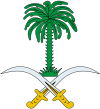- Demographics of Saudi Arabia
-
This article is about the demographic features of the population of Saudi Arabia, including population density, ethnicity, education level, health of the populace, economic status, religious affiliations and other aspects of the population.
Saudi Arabia's population as of the April 2010 Census was 27,136,977: 18,707,576 Saudi nationals and 8,429,401 non-nationals.[1] Until the 1960s, most of the population was nomadic or seminomadic; due to rapid economic and urban growth, more than 95% of the population now is settled. Some cities and oases have densities of more than 1,000 people per square kilometer (2,600/mile²). Saudi Arabia's population is characterized by rapid growth and a large cohort of youths.
Saudi Arabia hosts one of the pillars of Islam, which obliges all Muslims to make the Hajj, or pilgrimage to Mecca, at least once during their lifetime if they are able to do so. The cultural environment in Saudi Arabia is highly conservative; the country adheres to a strict interpretation of Islamic religious law (Shari'a). Cultural presentations must conform to narrowly defined standards of ethics. Men and women are not permitted to attend public events together and are segregated in the work place.
Most Saudis are ethnically Arab of whom they immigrated as pilgrims and reside in the Hijaz region along the Red Sea coast such as Jeddah, Makkah and Madina. According to a random survey, most would-be Saudis come from the Subcontinent and Arab countries.[2] Many Arabs from nearby countries are employed in the kingdom. There also are significant numbers of Asian expatriates mostly from India, Pakistan, Afghanistan, Bangladesh, Indonesia and the Philippines.[citation needed] In the 1970s and 1980s, there was also a significant community of South Korean migrant labourers, numbering in the hundreds of thousands, but most have since returned home; the South Korean government's statistics showed only 1,200 of their nationals living in the kingdom as of 2005[update].[3][4] There are more than 100,000 Westerners in Saudi Arabia, most of whom live in private compounds in the major cities such as Riyadh, Jeddah and Dhahran. The government prohibits non-Muslims from living in the city of Mecca.
Contents
Statistics
The following demographic statistics are from the CIA World Factbook, unless otherwise indicated.[5]
Age structure
0-14 years: 29.4% (male 3,939,377/female 3,754,020)
15-64 years: 67.6% (male 9,980,253/female 7,685,328)
65 years and over: 3% (male 404,269/female 368,456) (2011 est.)
Median age
total: 25.3 years
male: 26.4 years
female: 23.9 years (2011 est.)
Population growth rate
1.536% (2011 est.)
Birth rate
19.34 births/1,000 population (2011 est.)
Death rate
3.33 deaths/1,000 population (2011 est.)
Net migration rate
-0.64 migrant(s)/1,000 population (2011 est.)
Sex ratio
at birth: 1.05 male(s)/female
under 15 years: 1.04 male(s)/female
15-64 years: 1.27 male(s)/female
65 years and over: 1.03 male(s)/female
total population: 1.17 male(s)/female (2010 est.)Infant mortality rate
total: 16.73 deaths/1,000 live births male: 19.19 deaths/1,000 live births female: 14.14 deaths/1,000 live births (2010 est.)
Life expectancy at birth
total: 73.87 years male: 71.93 years female: 75.9 years (2010 est.)
Total fertility rate
2.35 children born/woman (2010 est.)
Urbanization
85% of total population (2011)
Nationality
noun: Saudi(s)
adjective: Saudi or Saudi ArabianReligion
The Government does not conduct census on religion, but estimates put the percentage of the majority Sunni Muslims at 85-90% while Shiites, who comprise the largest Muslim minority, at 10-15% of the population.[6] Shiites (Twelvers) are primarily concentrated in the Eastern Province, where they constitute over a third of the population. Other smaller communities (Ismailis and Zaidis) reside in the South, with Ismailis constituting around half of the population of the province of Nejran, and the Holy Islamic cities of Mecca and Medina.
References
- ^ "Saudi Gazette: Nov. 24, 2010 - Census shows Kingdom’s population at more than 27 million" [1]
- ^ Siraj Wahab (30 July 2009). "It’s another kind of Saudization". Arab News. http://archive.arabnews.com/?page=1§ion=0&article=124999&d=30&m=7&y=2009. Retrieved 13 January 2011.
- ^ Seok, Hyunho (1991). "Korean migrant workers to the Middle East". In Gunatilleke, Godfrey (ed.). Migration to the Arab World: Experience of Returning Migrants. United Nations University Press. pp. 56–103. ISBN 9280807455.
- ^ "President Roh Moo-hyun's Official Visit to the Kingdom of Saudi Arabia". Cheongwadae (Office of the President), Republic of Korea. 2007. http://english.president.go.kr/cwd/en/diplomacy/diplomacy_2007_20.html. Retrieved 2007-04-23.[dead link]
- ^ The World Factbook - Saudi Arabia
- ^ http://arabic.cnn.com/2007/middle_east/3/8/shiite-saudi/
External links
 Saudi Arabia topics
Saudi Arabia topics- Index
- Outline
History 
Geography Law Politics - King
- Cabinet
- Allegiance Council
- National Security Council
- Consultative Assembly
- Foreign relations
- Nuclear program
- Mabahith (secret police)
Military Economy Society - Censorship
- Crime
- Demographics
- Education
- Healthcare
- Human trafficking
- Obesity
- Prostitution
- Religion
- Terrorism
Culture Symbols Ethnic groups in Asia Sovereign
states- Afghanistan
- Armenia
- Azerbaijan
- Bahrain
- Bangladesh
- Bhutan
- Brunei
- Burma (Myanmar)
- Cambodia
- People's Republic of China
- Cyprus
- East Timor (Timor-Leste)
- Egypt
- Georgia
- India
- Indonesia
- Iran
- Iraq
- Israel
- Japan
- Jordan
- Kazakhstan
- North Korea
- South Korea
- Kuwait
- Kyrgyzstan
- Laos
- Lebanon
- Malaysia
- Maldives
- Mongolia
- Nepal
- Oman
- Pakistan
- Philippines
- Qatar
- Russia
- Saudi Arabia
- Singapore
- Sri Lanka
- Syria
- Tajikistan
- Thailand
- Turkey
- Turkmenistan
- United Arab Emirates
- Uzbekistan
- Vietnam
- Yemen
States with limited
recognition- Abkhazia
- Nagorno-Karabakh
- Northern Cyprus
- Palestine
- Republic of China (Taiwan)
- South Ossetia
Dependencies and
other territories- Christmas Island
- Cocos (Keeling) Islands
- Hong Kong
- Macau
Categories:- Demographics by country
- Saudi Arabian society
- Demographics of the Middle East
Wikimedia Foundation. 2010.

